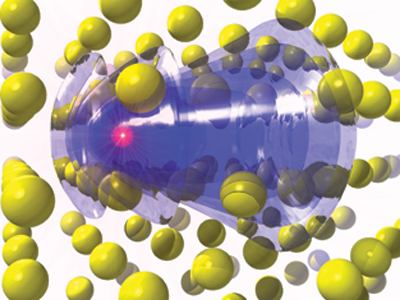PRL Cover: "Nonadiabatic Forces in Ion-Solid Interactions: The Initial Stages of Radiation Damage”
In a recent article a collaborative research team, including nanoGUNE’s Theory Group Leader Emilio Artacho and researchers from the Center of Materials Physics and the Donostia International Physics Center in the same campus, has studied the radiation damage processes beyond the Born-Oppenheimer approximation using time-dependent density functional theory. The article has been featured on the cover of the Physical Review Letters journal on 25 May 2012
As said in the abstract, the Born-Oppenheimer approximation is the keystone for molecular dynamics simulations of radiation damage processes; however, actual materials response involves nonadiabatic energy exchange between nuclei and electrons. In this work, time dependent density functional theory is used to calculate the electronic excitations produced by energetic protons in Al. The authors study the influence of these electronic excitations on the interatomic forces and find that they differ substantially from the adiabatic case, revealing a nontrivial connection between electronic and nuclear stopping that is absent in the adiabatic case. These results unveil new effects in the early stages of radiation damage cascades.
Original Publication: Alfredo A. Correa, Jorge Kohanoff, Emilio Artacho, Daniel Sánchez-Portal, and Alfredo Caro, “Nonadiabatic Forces in Ion-Solid Interactions: The Initial Stages of Radiation Damage”, Phys. Rev. Lett. 108, 213201, DOI: 10.1103/PhysRevLett.108.213201
In a further publication in the same journal the following week the same theoretical methods are used to understand a long-standing anomaly in the behavior of H and He projectiles shooting through gold. The ability of performing predictive simulations of the effect of this kind of projectiles in matter is important for the solution of the nuclear waste problem, for space industry and for radiotherapy of cancer.
Original Publication: M. A. Zeb, J. Kohanoff, D. Sánchez-Portal, A. Arnau, J. I. Juaristi, and E. Artacho, “Electronic stopping power in gold: The role of d electrons and the H/He anomaly”, Phys. Rev. Lett. 108, 225504, DOI: 10.1103/PhysRevLett.108.225504

Model of the electronic wake (blue surfaces) generated by an energetic proton (red sphere) traveling in an aluminum crystal. The resulting change in electronic density is responsible for modification of chemical bonds between the atoms and consequently for a change in their interactions.
Emilio Artacho
Theory Group
CIC nanoGUNE Consolider
Tolosa Hiribidea 76 20018 Donostia – San Sebastian
e.artacho@nanogune.eu
www.nanogune.eu
